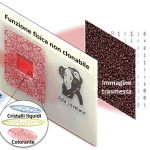
A new artwork for Enlighting Mind
January 30, 2024
Materiali fotonici per password più sicure
February 6, 2024The National Institute of Optics of the CNR and the National Institute of Metrological Research have developed a new class of highly secure password generators, using materials that interact with light. This technology may find application in authentication, anti-counterfeiting processes and in the secure communication of quantum data. The results of the work were published in Nature Materials
The security of the passwords we use to access web applications, online services or to carry out banking transactions is threatened daily by a growing number of cyber attacks. In this context, researchers – from the National Institute of Optics of the National Research Council of Florence (Cnr-Ino) and the National Institute of Metrological Research (INRiM), in collaboration with the Universities of Florence and Siena and the Technische Universität of Berlin (Germany), have developed technology to create more secure passwords.
In the article, published in the journal Nature Materials, the authors explain that passwords are generated by illuminating a thin layer of plastic material with a laser light, which changes its properties due to the effect of the light itself. The latter, when crossing it, is disordered in an unpredictable but reproducible way and the transmitted image allows the processing of extremely complex cryptographic keys to be violated. “Disordered photonic systems, when interrogated with laser light, provide an information-rich optical response from which a cryptographic key can be extracted. The key is not recorded in a memory but is extracted on request, thus reducing the risk of cyber attacks. I believe that the decisive element of our work was the use of complex materials that can be reconfigurable on multiple levels, which allow greater security of the generated key”, states Francesco Riboli, lead researcher at the Cnr-Ino.
Diederick S. Wiersma, professor at the University of Florence and President of INRiM, explains that: “Disordered optical systems have been used in various areas of photonics to create innovative sources and advanced light detection devices. This research exploits their intrinsic disorder as a source of secure information in the field of cryptography.”
The materials used in the research have an internal microscopic structure so complex as to be immune to possible cloning, and their use allows the cryptographic algorithms to be modified reversibly and quickly, through a simple LED light. “We used liquid crystals doped with a dye and dispersed in a thin polymer film, a low-cost, flexible but at the same time unique and irreproducible material,” continues Sara Nocentini, INRiM researcher. “By analyzing the information content of passwords generated with reconfigurable technology on multiple levels, we have verified that the latter are characterized by greater entropy – and therefore security – than static ones”.
The developments of this research could lead to the creation of new anti-counterfeiting devices and more secure authentication protocols. “The interdisciplinary nature of this research, which embraces photonics, materials science and cryptography, could have an impact both on the development of classical technologies and on the discovery of new quantum technologies”, concludes Francesco Saverio Cataliotti, director of the Cnr-Ino.
Publication: Nocentini S., Rührmair U., Barni M., Wiersma D.S. and Riboli F. (2024) All-optical multilevel physical unclonable functions, Nat. Mater. (2024). All thanks and references to the funding projects are present in the publication.
Some news published





